Eastern Ground Parrot
Eastern Ground ParrotPezoporus wallicus wallicust | |
|---|---|
| Kingdom: | Animalia |
| Phylum: | Chordata |
| Class: | Aves |
| Order: | Psittaciformes |
| Family: | Psittacidae |
| Status | |
| World: | Least concern (IUCN 2025) |
| Australia: | INot Listed under EPBC Act |
| Victoria: | Endangered (FFG Threatened List 2025) |
| FFG: | Listed, (no Action Statement) |
| Queensland: | Vulnerable |
| New South Wales: | Vulnerable |
| South Australia: | Endangered |
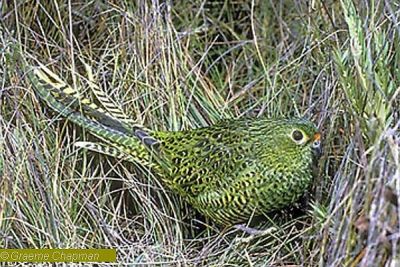
The Eastern Ground Parrot Pezoporus wallicus wallicus is a secretive bright green ground dwelling parrot which is seldom seen. It inhabits dense heathlands in or near coastal regions of eastern and south-eastern Australia.
Two sub-species of the Ground Parrot occur in Australia:
- Pezoporus wallicus wallicus – Queensland, New South Wales, Victoria and South Australia (eastern sub-species)
- Pezoporus wallicus leachi - (Tasmanian sub-species)
Other related species of Ground Parrot:
- Pezoporus flaviventris (Western Ground Parrot, Western Australia)
Source: (AFD 2025).
Distribution
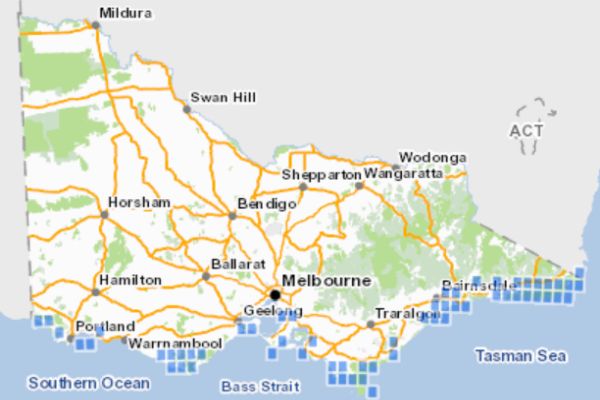
All known historic records of Ground Parrot in Victoria. Source: VBA 2020.
In Victoria, many of the populations have suffered a decline to a point where their existence is now in doubt.
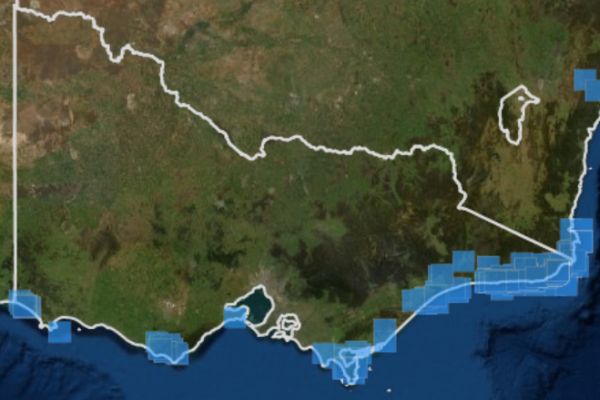
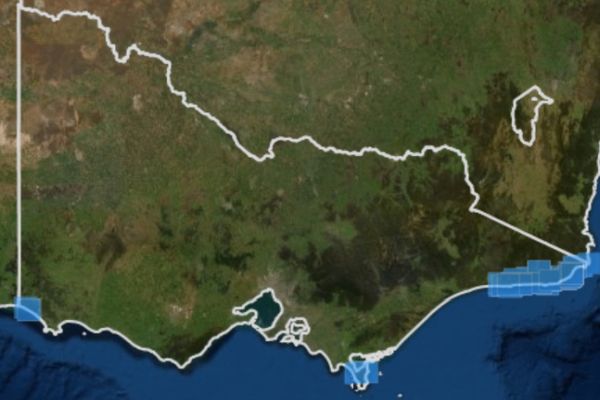
Wilson’s Promontory National Park remains a viable area for the species. In south-west Victoria the Eastern Ground Parrot was previously recorded in the Nelson area of the Lower Glenelg National Park and the Discovery Bay Coastal Park. The populations which once occurred within the Great Otway National Park (Carlisle River heathlands, Crinolone Creek, Devondale, Mt McKenzie and Cape Otway) have become highly fragmented due to landscape change and were considered to be in decline in 2000 due to no recent records (Garnett and Crowley 2000). Populations around the Mornington Peninsula, Port Phillip Bay were noted to be in decline in 1992. (SAC 1992).
The population in East Gippsland, particularly Croajingolong National Park remains the stronghold for the species in Victoria but major fires in January-February 2020 are likely to have severely impact on the species.
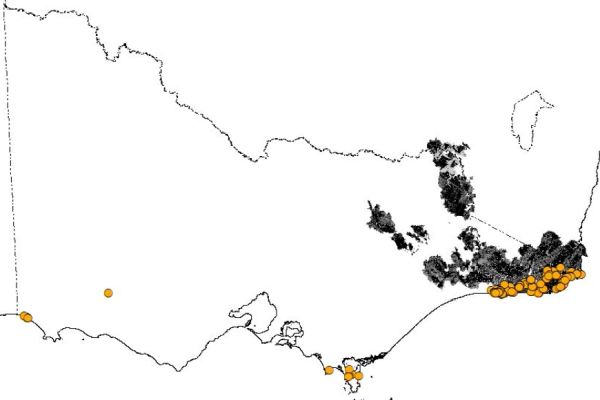
Ecology & Habitat
The Eastern Ground Parrot inhabits dense heathlands and sedgelands.
Breeding
Breeding occurs from September to December in Victoria. Nests are well hidden often with a tunnel in the surrounding dense plants (Forshaw 2002).
Feeding
The diet of Victorian populations has been studied by Meredith & lsles (1980) and Forshaw (1981). It comprises seeds from the following plants;
| Plant family | Species |
| Haloragaceae | Gonocarpus sp. (raspworts) |
| Lauraceae | Cassytha glabella (Dodder-Laurel) Cassytha melantha |
| Cyperaceae | Baumea acuta (Twig Rush) Baumea juncea Gahnia sp. (Saw-sedges) Lepidosperma sp. (Saw sedge & Rapier sedge) Schoenus brevifolius (Bog-sedge) |
| Juncaceae | Juncus sp. (Rushes) |
| Restionaceae | Restio complanatus (Flat Cord Rush) |
| Xanthorrhoeaceae | Xanthorrhoea sp. (Grass-tree) |
| Adapted from (Bryant 1994). | |
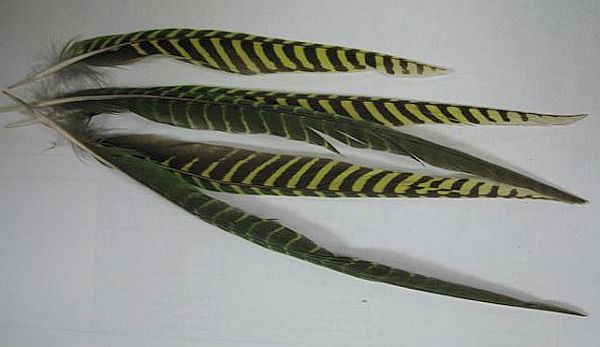
Population Status
In Victoria, the Ground Parrot has suffered a significant decline since European settlement. In 1990 the population was estimated to be; Croajingolong National Park 200-250, Discovery Bay 50-60, Wilson’s Promontory National Park 200-250, and Carlisle heathlands approximately 3 records (Meredith and Jaremovic 1990, SAC 1992).
The Victorian population estimates are very low when compared with estimates in New South Wales - 2000 (OEH 2018), Queensland 2900-4900 (Forshaw 2002) and Tasmania -100,000 (Forshaw 2002).
BirdLife International 2025 considers the conservation status of Pezoporus wallicus (no distinction between sub-species) as Least Concern due to it occupying a very large range and although in decline it is not believed to be a sufficiently rapid decline to approach the thresholds for Vulnerable. This assessment should be be considered outdated as there is no distinction between sub-species. Also the bushfires in January-February 2020 burnt a large area of Eastern Ground Parrot Pezoporus wallicus wallicus habitat in eastern Australia which will undoubtedly have had an impact on the eastern sub-species.
Threats
Habitat loss/fragmentation
The Eastern Ground Parrot does not undertake regular long-distance migrations or movements which makes it particularly susceptible to impacts such as habitat fragmentation or habitat loss. Fire is a necessary component of providing renewal of heaths and sedgeland habitats but large-scale fires which burn out all the habitat, too frequent burns or fires during the breeding season can be detrimental because the habitat necessary for survival is lost, i.e. loss of adequate cover and food source.
Introduced predators
The Red Fox and Feral Cat pose a threat to ground dwelling and ground nesting birds such as the Eastern Ground Parrot. Threats from these predator species are elevated when habitat is fragmented by cleared land, tracks, or extensive burnt areas which remove all cover.
Disease
Psittacine Circoviral Disease (PCD) is a viral disease that is commonly named the “beak and feather” or “bald cocky” disease, that affects parrots and related species (DEWR 2004). The Psittacine Circovirus occurs naturally in the wild and is widespread. This virus causes death to the cells of the beak and feathers. The virus multiplies in the liver and can be transmitted orally or in faeces or feathers. It is one of the smallest and most resistant disease-causing viruses and probably remains alive for many years in nesting sites (DEWR 2004).
Conservation & Management
Previous Management documents relating to Victoria
R.A.O.U Conservation Statement (1983)
This statement is based on a combination of surveys and observations which looked at the condition of Ground Parrot population throughout Australia. Specifically, directed at the biology of the Ground Parrot, its effects caused by fire regimes and its distribution throughout Australia. This statement highlighted the threats causing the decline of the population. Overall, the document provides a greater knowledge and understanding of the species (Meredith 1984).
Technical Report - Current status and management of the Ground Parrot in Victoria (1990)
This technical report looked at the status of the ground parrot and set out a general list of guidelines which outlined the management of the heathlands, particularly with regard to the management of fires. This report aimed to ensure optimal habitat conditions for the ground parrot populations, whereby providing a model assumption to estimate the carrying capacity. Specifically looking at details of a fire regime, Meredith and Jarernovic investigated attributes of where to burn, size of burns, shape of burns and seasons of burning. This proposal was mainly focused on East Gippsland – Croajingolong National Park, however included other prominent locations including Wilson’s Promontory National Park, Cape Otway National Park and Carlisle Heathlands (Meredith and Jaremovic 1990).
Croajingolong National Park Management Plan (1996)
The Croajingolong National Park Management Plan (NRE 1996) recognises the importance of the Eastern Ground Parrot and outlines the management actions for this area, including fire management. Particularly, the needs for ecological sound burning for particular sections of the park which are known as prime Ground Parrot habitat. Whereby, proposals were put forward to maintain fire regimes appropriate to the conservation of the native flora and fauna. In addition, the management plan also recognised the importance of introduced predation by foxes, cats and dogs. Whereby, developing strategic plans to protect native species (NRE 1996).
Croajingolong National Park Management Plan - (1996) pdf
Environment Protection and Biodiversity Conservation Act - EPBC Act (1999)
Under this Act the Psittacine Circoviral Disease which is known to affecting threatened psittacine species is listed as a key threatening process. Through the EPBC Act the Australian Government is preparing a ‘Threat abatement plan for Psittacine (beak and feather) Circoviral Disease affecting endangered species.’ With the intentions of managing and reducing the impacts of PCD in endangered birds. Through this abatement plan, techniques of how to promote the recovery, development of new control mechanisms, educating relevant groups and obtaining information to get a better understanding of the disease will be capable (DEWR 2004).
Action Plan for Birds of Australia- Recovery Outline for the Eastern Ground Parrot (2000)
In 2000 Garnett and Crowley developed a book that outlined recovery plans for all bird species of Australia. Included in that was the Eastern Ground Parrot. The outline basically stated the past and present range and abundance, ecology and threats. It also summarised actions to be completed or that were underway and management actions that were required. Furthermore, it proposed a guide for the financial resources required for recovery to be carried out over the duration of 2001 to 2005. With an overall projected funding requirement of $329,500 (Garnett and Crowley 2000).
Southern Ark Project – Department of Energy, Environment and Climate Action (DEECA)
This program has been running since 2003 in East Gippsland covering around 1 million hectares including state forest, national parks and private land from the Snowy River valley to Cape Howe. The program applies integrated large-scale fox control combined with a joint research and management approach, where management methods are continually improved by what has been learnt from research. The Eastern Ground Parrot is thought to directly benefit through this program.
Glenelg Ark Project
Glenelg Ark is a partnership between the Department of Environment, Land, Water and Planning and Parks Victoria. It is funded through the State Government’s Weeds and Pest on Public Land Initiative. Glenelg Ark commenced in 2004. By 2016 the program had expanded from its original 10,000 ha to cover 90,000 ha of state forest and national park covering 70,000 ha of treatment area. Of particular benefit to the Eastern Ground Parrot is fox control in the Lower Glenelg National Park and Discovery Bay Coastal Park.
More information: https://www.swifft.net.au/cb_pages/project_glenelg_ark.php
Suggested conservation measures for the Eastern Ground Parrot
Monitoring
Initiate monitoring throughout heathland and sedgelands habitats to gain a greater understanding and knowledge of the current status of the parrot.
Habitat management
Continuously maintain the appropriate habitat for the Eastern Ground Parrot through mosaic burning that allows movement between patches of different areas post fire recovery. This method is likely to be important to ensure rapid decolonisation of recently burnt areas (Garnett and Crowley 2000).
A study of Ground Parrot management was conducted by Meredith and Jaremovic (1990); it recommended the following burning program for the Carlisle State Park graminoid heathlands – 210 hectares to be burnt every two years over a 16-year cycle. It is suggested that the sustainability may decline if habitat is left unburnt for more than 16 years (Garnett and Crowley 2000).
A study of Ground Parrot habitat and fire (Baker et el. 2010) found areas of long-unburnt habitat, greater than 20 years post-fire supported high densities of 2 or more birds per 10 ha. The report recommends, management plans should aim for exclusion of fire for at least 7 years post-fire for Ground Parrots. Management plans should also identify long-unburnt refuges for Ground Parrots.
Landscape-scale, targeted surveys of Ground Parrots were carried out at 80 heathland sites between Marlo and Mallacoota, Victoria in 2013. (Bluff 2016). Landscape modelling of the expected total area occupied by Ground Parrots between 1979 and 2013 suggested a strong peak would have occurred in the late 1990s; suitability of habitat over much of the landscape is now declining. The report inferred a decline in Ground Parrot occupancy in the survey area in recent decades.
Consideration of improved habitat management for the Eastern Ground Parrot, particularly in the Carlisle heathlands, Great Otway National Park and Lower Glenelg National Park may assist in re-introduction options for the future.
Predator control
Ensure that Park and Reserve management plans and actions consider the need for fox and cat control programs.
Captive breeding program
Establish a population of the Eastern Ground Parrot in captivity. A captive bred population may also assist in recovery of the species after catastrophic fire events such as the 2020 eastern Victoria bushfires. Captive bred birds may also provide scope for re-occupancy of areas previously known to support the Eastern Ground Parrot when ecological conditions are assessed as being suitable to maintain a self-supporting population.
Projects & Partnerships
- Bushfire Recovery- Community Wildlife Reporting Program - this project specifically targets community observations of the Eastern Ground Parrot in areas burnt by bushfires.
- Eastern Ground Parrot project - Far East Victoria Landcare. View notes from the SWIFFT Seminar on 25 March 2021
References & Links
AFD (2025) Australian Faunal Directory, Pezoporus wallicus check list
Baker, J., Robert, J., Whelan, A.B., Evans, C., Moorre, S., and Norton, M. (2010) Managing the Ground Parrot in its fiery habitat in south-eastern Australia. Emu 110(4) 279-284 https://doi.org/10.1071/MU10014 Published: 26 October 2010 https://www.publish.csiro.au/mu/MU10014
BirdLife International. 2022. Pezoporus wallicus. The IUCN Red List of Threatened Species 2022: e.T22685226A218953796. https://dx.doi.org/10.2305/IUCN.UK.2022-2.RLTS.T22685226A218953796.en. Accessed on 11 June 2025.
Bluff, L. (2016) Ground Parrots and fire in east Gippsland, Victoria: habitat occupancy modelling from automated sound recordings. Emu 116(4) 402-410 2016 https://www.publish.csiro.au/mu/mu16014
Bryant S.L. (1994) Habitat and Potential Diet of the Ground Parrot in Tasmania EMU Vol. 94, 166-171, 1994
Department of the Environment and Water Resources (DEWR), 2004, Beak and feather disease (psittacine circoviral disease) - Fact sheet, Natural Heritage Trust, accessed 4th November 2007.
Department of Natural Resources and Environment (NRE), 1996, Croajingolong National Park- Management Plan, Parks Victoria, 2007,
FFG Threatened List (2025) Flora and Fauna Guarantee Act 1988 - Threatened List - March 2025, Department of Energy, Environment and Climate Action (DEECA) , Victoria.
Forshaw, J.M. 1981. Australian Parrots, 2nd edn. Lansdowne Press, Melbourne
Forshaw J.M, 2002, Third Revised Edition: Australian Parrots, Alexander Editions,
Garnett S.T and Crowley G.M, 2000, The Action Plan for Australian Birds 2000, Natural Heritage Trust, Australia.
IUCN (2025) See: BirdLife International 2022.
Meredith C.W, 1984, RAUO Conservation Statement. No 1. The Ground Parrot- Pezoporus wallicus Kerr.
Meredith, C.W. & Isles, A.C. 1980. A study of the Ground Parrot (Pezoporus wallicus) in Victoria. Publication 304. Environmental Studies Division of the Ministry for Conservation, Victoria.
Meredith C.W and Jarernovic R, 1990, ‘Current status and management of the ground Parrot in Victoria’, Technical Report Series No. 58, Arthur Rylah Institute for Environmental Research, Department of Conservation and Environment, Melbourne.
Office of Environment & Heritage, NSW (2018) Threatened species profile: Eastern Ground Parrot Accessed 11 June 2025, 2020.
Queensland Government, Threatened species classes, Ground Parrot – Vulnerable. Accessed 11/06/2025.
Scientific Advisory Committee (SAC), 1992, Final Recommendation on a Nomination for listing- Pezoporus wallicus (Kerr), Flora and Fauna Guarantee, Victoria.
National Parks and Wildlife Act 1972 South Australia —21.6.2023 Schedule 7—Endangered species Eastern Ground Parrot
More Information
Images of the Ground Parrot by Graeme Chapman
Atlas of Living Australia - Eastern Ground Parrot
Please contribute information regarding the Eastern Ground Parrot in Victoria - observations, images or projects. Contact SWIFFT

